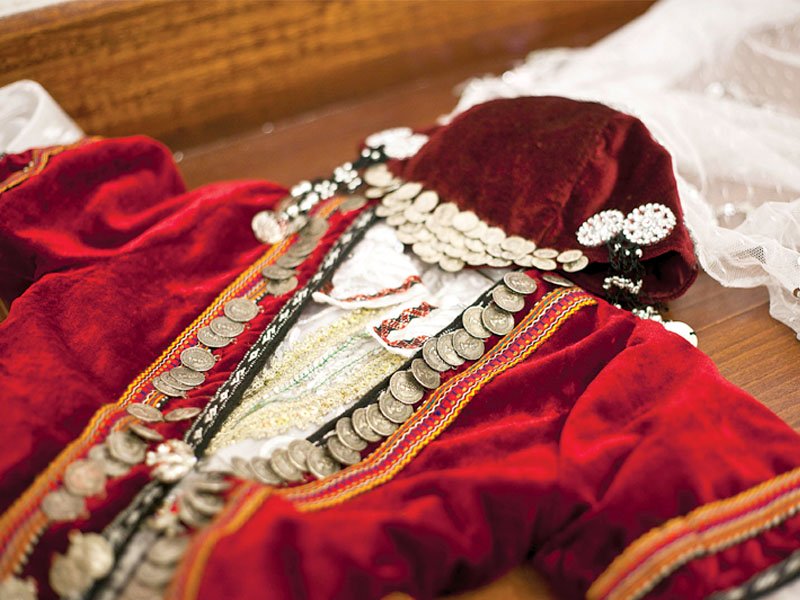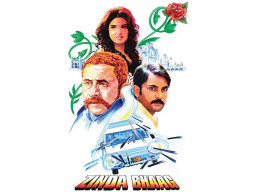
ISLAMABAD:
The Iranians take great pride in their post-Islamic Revolution progression, and this becomes apparent as one browses through the ongoing cultural showcase at the Pakistan National Gallery of Arts, Islamabad.
The week-long Iranian Cultural Week, which was inaugurated by Ambassador Ali Raza Haqqiqian on Tuesday, celebrates the country’s over three decades as an Islamic Republic.
The illuminated gallery space exhibits art, handicraft, portraits, posters and apparel in separate sections. A video installation plays scenes from what appears to be a local film, with soft music and intermittent dialogue setting the ambience.

With thick embroidery and accessories, such as coins, beads, sequins and tassels, the clothes and their colours are very oriental in style. PHOTO: MYRA IQBAL/EXPRESS
Garbed in traditional, layered robes, two women stand by a stall of clothing. Mrs Kazami, who speaks Persian, smiles as she takes the guests through her collection of paintings and drawings on display. Her work is diverse, including musawarri (drawing), naqashi (prints) and nigarnaweesi (penmanship or calligraphy).
The highly-stylised pieces comprise traditional calligraphy, soft florals and miniaturesque drawings of people engaging in various activities. A bearded mystic meditating in the wilderness is one of the prominent pieces among the many framed canvases. The artist has also designed leather-bound covers for the Holy Quran and cases for pens, with intricately-detailed engraving.
Mrs Shadkhaam is a fashion designer, whose creations adorn a substantial part of the gallery. Draping from the walls or piled up on stalls, they are reminiscent of the ornamented clothing one usually sees at local handicraft shops in the country.
The fabrics and colours are very oriental in style. The thick embroidery and accessories, such as coins, beads, sequins and tassels, form a variety of patterns ranging from casual kurtis to silken frocks and decadent gowns.
Another artist, Muhammad Ali Farrasati, is busy etching with ink on paper with an indigenous wooden quill, reminiscent of a qalam. He layers the piece evenly and effortlessly, drawing the guests to his stall.
Pointing to the intertwined strokes, he illustrates how the letters form a verse. With about two decades of calligraphy experience under his belt, his collection boasts of a traditional style of calligraphy.
Farrasati also displays illustrations, which oddly resemble Mughal Art, with rustic women cooking over a hearth and the men smoking hookah or teaching astronomy to their children.
Silverware and ornate pieces are neatly lined up in a visually engaging display. Engraved with figurative forms or florals, they are either minimalist or imbued with turquoise paint.
The craftsman, who introduces himself as Mr Kawahmi, is engrossed in engraving a metallic plate by a stall that stocks a large collection of his work on sale. He has been practicing this craft for about four decades.
A chaikhaana (tea house), complete with golden tea sets, small glass cups and ingredients, such as misri (crystallised sugar lumps) and saffron, are decorated in one corner, welcoming guests to taste the traditional kahwah (traditional green tea). There are some cookies and candy as well.
Moreover, stalls of manuscripts and books on religion and culture are sprawled on separate stalls. They include the Holy Quran and Deewan-e-Ghalib, among others. Black and white portraits of those martyred in the revolution, stand out against the bright photographs of construction sites, mosques, mausoleums and natural landscape, luring the viewer to take in the sights of the land.
“The cultural showcase is all about our heritage,” says Adeela Khishawis, the cultural counsel. “From ancient Iran to more modern and recent developments, this is [to pay] homage to our lifestyle and history.”
‘Mo’afagh bashed’ (good luck) to the organisers of the showcase!
Published in The Express Tribune, February 7th, 2014.
Like Life & Style on Facebook, follow @ETLifeandStyle on Twitter for the latest in fashion, gossip and entertainment.
COMMENTS (2)
Comments are moderated and generally will be posted if they are on-topic and not abusive.
For more information, please see our Comments FAQ



































































Can we get influenced by their Integrity, Sovereignty & Islamic Revolution? No! we only take nudity from other cultures.